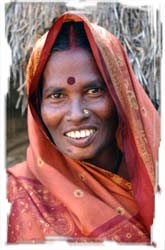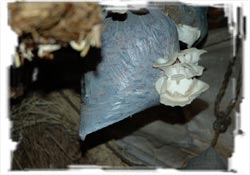CIMMYT E-News, vol 3 no. 2, February 2006
 The CIMMYT-convened Rice Wheat Consortium for the Indo-Gangetic Plains (RWC) reaches out to the poorest of the rural poor in India’s Bihar state.
The CIMMYT-convened Rice Wheat Consortium for the Indo-Gangetic Plains (RWC) reaches out to the poorest of the rural poor in India’s Bihar state.
Mrs. Lal Muni Devi and her family live in a windowless, single-room, thatched roof house in the village of Azad Nagar, half an hour’s drive from the city of Patna in Bihar state in India, in the impoverished eastern section of the vast Indo-Gangetic Plains. Most farms here are small and almost all farmers grow two crops a year; rice during the wet, monsoon season, and wheat on the same fields during the dry winter. The RWC conducts farmer-managed trials and demonstrates practices that conserve soil quality and water and cut farmers’ production costs. These include direct seeding of wheat and rice without previously cultivating the soil—a practice known as zero-tillage. In the case of rice, this involves the radical measure of growing it on dry land; that is, without flooding fields or puddling the soil.
But there’s a catch: Devi is not a farmer. She and her family are among the landless poor who cannot directly benefit from the new, resource-conserving practices that are starting to make a difference for smallholder farmers in her community. In fact, what little income she and her family earn comes from selling their labor to the farmers. They prepare the land for rice, for example, and transplant the rice seedlings from nurseries to the paddies. They also weed the wheat fields and harvest the crops, all by hand.
Providing opportunities for people like Devi is one part of an RWC project being implemented in partnership with the Indian Council for Agricultural Research (ICAR) and supported by the International Fund for Agricultural Development (IFAD) in the district. “The landless are typically the core rural poor”, says Olaf Erenstein, CIMMYT socioeconomist in South Asia. “But they are relatively invisible, difficult to reach, and often forgotten by agricultural research and development organizations. The challenge is to provide them with significant income-generating options by building on their skills and the limited assets they command.”
Devi’s house is lit only by small kerosene lamps. Inside, balls of wheat straw hang on twine from the roof. Oyster mushrooms grow on each ball, thriving in the relatively dark and damp interior of the house. There is a market for them in the nearby city and wheat straw is plentiful. The spores are readily available and, at 50 rupees a bag (the equivalent of about US$ 1.20), not expensive. The economics are good and the mushrooms don’t require much labor.

“I’ve just sold my first kilo and received 250 rupees,” she smiles, happy at the prospect of having cash for household needs. In Azad Nagar, women have formed a self-help group and are all growing the mushrooms, a proficiency they acquired through the project
This is the first season and the group represents a small, pilot initiative, but the impacts are already being felt. “Now we have tasted the delicacy ourselves, the oyster mushrooms, for the first time,” Devi says. The women recognize new bonds among themselves in their community and control the money they earn. “I need to buy some new clothes for the family,” Devi says. “And if there is something left, I want to buy some jewelry.”
For more information contact Olaf Erenstein (o.erenstein@cgiar.org)

